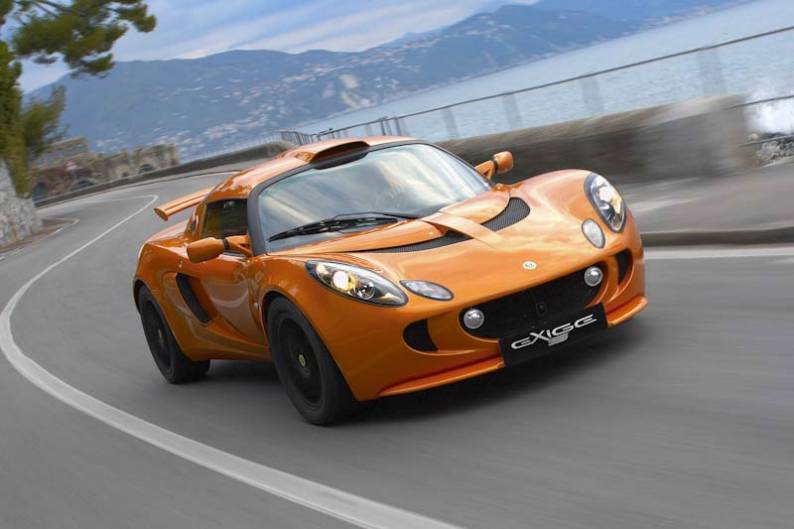
RAC sale – up to 33% off*
• Roadside cover from £5.29 a month†
• We get to most breakdowns in 60 mins or less
• Our patrols fix 4/5 breakdowns on the spot

BY ANDY ENRIGHT
Introduction
The Lotus Exige is what could be termed a Marmite car - you either love it or hate it. Many cannot see the appeal of a plastic bodied car with a 1.8-litre engine that costs quite so much and seems to offer so little capability. These people will never have felt steering lighten up as a car dances at the limit on a race track, nor will they have ever executed a perfect heel and toe gear change to leap flat on the gas again. If that is your thing, you'll get the Lotus Exige and appreciate where the money has been spent. Here's how to find a decent used Series 2 car.
Models
Models Covered: (2 DR COUPE 1.8 PETROL [EXIGE, EXIGE S, EXIGE 240R, EXIGE CUP 240, EXIGE S BRITISH GT SPECIAL EDITION])
History
I must admit to being wholly disappointed when I first clapped eyes on the Exige S2. Whereas the S1 seemed pumped full of attitude and Tasmanian Devil testosterone, the Exige S2 was a slighter, dare I say more feminine looking thing. The intimidation factor seemed to have vanished but it didn't take long behind the wheel to figure out it was a markedly smarter and more capable car. The first examples landed in dealerships in May 2004, Lotus replacing the S1's lumpy K-series engine with a civilised 189bhp Toyota powerplant.
Few thought this was all that Lotus had planned for the Exige and in 2005 a supercharged version was announced. The limited run 240R. Many buyers snapped these cars up, drawn by the promise of exclusivity but those who knew the car industry could predict what would come next. Sure enough, a productionised version of the supercharged Exige followed, dubbed the Exige S. With 240bhp on tap, it was fast enough to humble many quite serious Porsches and Ferraris. Since then there have been other specials such as the 2006 Sport Cup 240, the 2007 Cup 255 and the 2007 Exige S Britsh GT special Edition but to all intents and purposes, the Exige range hinges around two cars, the normally aspirated Exige and the supercharged Exige S. In 2006 Lotus launched two Touring packs that take the edge off the Exige's rawest qualities and two Sport packs that enhance this car's headbanger appeal.
2006 also saw Lotus introduce a number of detail improvements to the Exige including LED rear lights which are 36 per cent brighter than tungsten bulbs and illuminate 0.2 seconds quicker (or one Exige car length at just 43mph). The classy extruded aluminium pedals have been ditched in favour of steel items that are lighter. The pedal box was always the weakest point of the Exige, and it was unforgivable that in such a focused driver's car, it was often virtually impossible to execute a heel and toe downchange. With an electronic throttle, a reduced brake pedal ratio and a change in pedal positioning, the pedal box is now better suited to expert drivers.
Plans for a manic 271bhp Exige GT3 special were announced in 2007.
What You Get
Rather than getting mired in the detail changes of each and every Exige variant, let's focus on the common DNA that runs through every Exige S2. It's still a task to get in and out with any dignity, although a tip for prospective owners is to watch Lotus' test drivers in action and attempt to emulate their method for entering and exiting the cabin. The words 'sell out' initially flash across your mind as you take in the electric windows, carpets and stereo of the cars equipped with the Comfort Pack but even the most masochistic will appreciate these luxuries. There is a Performance Pack with carbon fibre bits, a harness and roll cage. Air conditioning is an option but it's well worth choosing, the Toyota engine doing a good job of basting the Exige's occupants.
Compare the prices to other sports coupes and your first thought may well be that there's not a whole lot of car for the money, a decent Porsche Cayman costing about the same as an averagely specified Exige. It's certainly well into Porsche and BMW M territory and some of the interior fit and finish elements aren't what could best be described as top drawer. Nevertheless, the Exige still possesses the sort of exotic feel that escapes even the suave Porsche.
What You Pay
Please fill in the form here for an exact up-to-date information.
What to Look For
Whereas the old Exige S1 was an experience that kept owners awake at night, life with the S2 is far simpler. A better engine and more stringent build quality has seen the number of snags drop dramatically. One issue that has manifested itself is the heater fan which is in a notorious water trap and which can fail to operate at all speeds. Occasionally, the cast wheels will be difficult to balance and the headlamp units can mist up. Play in the steering around the straight ahead can signal a worn rack. Check the tyres for signs of wear. Kwik-Fit will not have replacements in stock.
Replacement Parts
(approx based on a 2000 Exige 1.8) Those spares that are interchangeable with the Elise are generally agreeably cheap, as are servicing costs. Front discs cost £90, a headlamp unit around £95 and a new windscreen is £240. A door mirror is £85.
On the Road
The first Exiges used that rather rattly K-series engine but the latest generation cars use a far more sophisticated powerplant. The unit in question is essentially the same 1.8-litre VVTL-i 189bhp Toyota unit once found in that company's Celica T-Sport sports coupe which may be similar in output to that car but behaves in a quite different manner. It's almost civilised at normal revs, feeling tractable and docile where the old engine would grumble obstreperously below 3,000rpm. Despite this, the Exige S2 is no faster in a straight line than its predecessor, the additional 80kg of weight nullifying any advantage the new engine bestows. Sixty will arrive in 4.9 seconds and 100mph flashes by in 13.2. The magic number with this engine is 6,200, that being the rpm where the cams change profile and all hell lets loose. Given its head, the latest car will nudge 150mph.
That this Toyota unit is the best engine for the job is evident within just a few hundred yards. The soundtrack from the twin rear tailpipes is so throaty that you'd swear the optional sports exhaust was already fitted. This powerplant's party piece is the way it switches cams at 6,200rpm, giving a glorious surge of extra power that you can't help wishing was available further down the rev range. Still, it's a treat when you get to experience it, offering a seamless stream of acceleration all the way up to the 8,200rpm red line. It's torquey too, with 181Nm (133.5 lbs/ft) of pulling power.
Go for an Exige S and things are even more fun. The slight hole in the normally aspirated car's torque curve before the cam phase is filled in beautifully in one long stream of acceleration. It gets to 60mph in 4.1 seconds and to 100mph in a fraction less than ten seconds. It's quicker to 60mph than a Porsche 911 Turbo and within a tenth of a second of Ferrari's F430, neither of these cars having a hope of replicating the Exige's 31mpg combined fuel consumption figure. Fuel economy may not seem too much of a concern to target buyers but when you have a mere 43.5-litre fuel tank, it equates to more laps between top ups.
Overall
If you're looking for a car that will destroy all comers at track days and get there and back without recourse to a crash helmet and small children laughing at you, the Lotus Exige is your weapon of choice. Fast, charismatic and huge fun, it's one of the least successful Lotuses ever. It's also one of the best. In S2 guise it's even agreeably reliable. I'd spend my money on the first of the Exige S models and be smug in the knowledge that you own one of the quickest cars in the real world.





![Audi RS6 [C7] (2013 - 2020) used car review](https://d1ix0byejyn2u7.cloudfront.net/drive/images/made/drive/images/remote/https_d2yv47kjv2gmpz.cloudfront.net/filestore/2/5/2_987c85fdd19659c/b6bb3fdc3604fafccb5318449d20932b/252_b89068e01b9a6af_100_100_70_c1_c_c.jpg)

